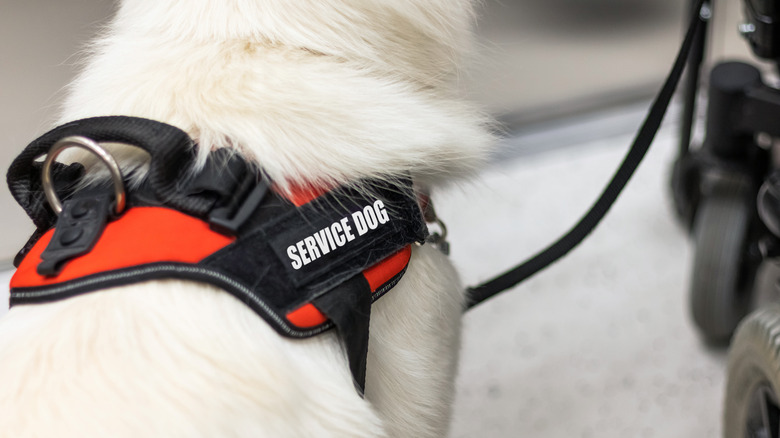The Best Way To Navigate TSA With Your Service Animal
Service animals have an important job to do. Sometimes that means taking to the sky to help their humans out. But just like their humans, service animals have to go through airport security with TSA, too. Although they aren't as frequent of fliers as humans, service animals do spend a lot of time in airports. In fact, hundreds of thousands of them are accounted for each year by the Bureau of Transportation Statistics.
Per the Air Carrier Access Act (ACAA), service animals are now only classified as dogs as it pertains to airline allowance. According to the Department of Transportation, these service dogs must be "individually trained to do work or perform tasks for the benefit of a qualified individual with a disability, including a physical, sensory, psychiatric, intellectual, or other mental disability." Emotional support animals, companion or comfort animals, and service animals that are not dogs are no longer permitted, according to the ACAA.
However, airlines are allowed to deny access to a service dog. According to the ACAA, if a dog is too big or heavy to safely fly in the cabin, is a threat to others, or causes significant disruptions in the cabin or airport they can be barred from flying. With all of that in mind, there are some important considerations for successfully getting your service dog through TSA. And remember, if you have questions at any point before or during travel, there is always an easy way to ask TSA.
Getting your service dog through TSA
For a lot of travelers, the TSA screening process can be nerve-racking. Luckily there are ways to make going through it as a family much easier and with your service animal, too. According to the TSA, you and your service animal can go through the standard or PreCheck lines together and be screened together or separately. However, if either of you set off a screener alarm, you will be subject to additional screening.
Just like with your luggage, your service animal's gear is also up for screening. To avoid any screening issues, the TSA recommends some helpful guidelines when packing your pup for the adventure: "Service animal collars, harnesses, leashes, backpacks, vests and other items are subject to screening. Please consider using items that have little to no metal. Items that are necessary to maintain control of the service animal do not need to be removed." They also recommend that, if your service dog has their own medications, you pack them separately and alert TSA that they are for your animal.
When going through security with your service dog, you must not touch the animal until inspection is complete. The department also notes that you won't be separated from your service animal at any point during the screening. You hold on to the leash and if there are any concerns about the process, ask for a supervisor or support specialist.
Other service animal security considerations
Before going through security, be sure to let your service animal use the bathroom. If there isn't an available animal bathroom area between security and your gate, you may need to leave the secure area. Should that happen, you will need to go through TSA screening again, but the department says you can ask to go to the front of the line when going back through.
Unless you're flying with a company like BarkAir, the first US-based airlines for dogs, the screening and complete airport process isn't made with dogs in mind. There is rigamarole you may need to deal with upon arrival, so it's good to be prepared if you can to make the process easier for you and your dog. It is possible that the airlines or airport personnel will ask questions about your dog's work as a service animal. The ADA National Network says that there are a few questions you may be asked about your service animal, including: "What tasks or functions does your animal perform for you? What has the animal been trained to do for you? Would you describe how the animal performs this task or function for you?"
It's possible you will also be asked for identification materials for your dog, which is not a legal requirement for a working service animal. It's also important to know that service animals are not legally required to wear vests or other identifying materials.
